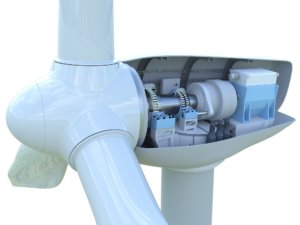 Location:NEW >>Industry Dynamics
Location:NEW >>Industry Dynamics

Since 2012, offshore turbines with total power outputs in excess of one GigaWatt (GW) have been coming on stream in European waters every year. According to WindEUROPE, Offshore wind in Europe saw a net 1,558 MW of additional grid-connected capacity installed in 2016.
Despite the challenges of constructing offshore turbines, the capacity there is expected to grow as suitable land-based sites become scarcer and operators take advantage of the greater consistency of wind at sea. The output power of offshore turbines also tends to be greater than their land-based counterparts. According to WindEUROPE the average power output of offshore turbines installed in 2016 was 4.8 MW. Turbines of 9 MW or more capacity are now in the launching stage – Vestas’ V164-9.5 MW development is a prime example.The generic turbine with a gearbox sports a two-point suspension provided by the two large bearings. The arrangement is used on turbines in the 6-MW range.
Offshore wind turbines also tend to have longer blades which impose greater forces on drivetrains. In addition, drivetrains and their bearings are at greater risk of corrosion due to the saltwater environment. Conducting maintenance offshore is difficult, potentially dangerous and costly, so operators are keen to reduce the frequency of maintenance visits, which places considerable demands on the rotor bearings and their ability to continue to function reliably in these conditions for long periods.
There are four common bearing design concepts for turbine rotor shafts. The first is a two-point suspension with a toroidal roller bearing on the rotor side and a spherical roller bearing on the generator side. This is used for turbines in the 6-MW category for example.
The generic turbine is designed with a three-point suspension. One point for the large mainshaft bearing and two other points on either side of the gearbox.
Other bearing features have also gotten attention. Bearing cages, for example, are generally made of machined brass or sheet metal, the latter being more often found in larger bearings. Where possible, cages are always installed in one piece, but for larger bearings, they may comprise rows of segments which are manufactured individually and positioned one behind the other. All types of cages can be inner-ring centered, which produces less wear and thus prolongs the service life of the bearing — clearly important where offshore wind turbines are concerned.
The cut-away shows how one OEM handles a direct drive configuration with a two-point suspension, on either side of the rotor.
In addition to offshore environment, bearings must also cope with the potentially damaging effects of high electric currents. For example, wind turbine generators are equipped with frequency converters which pose a new set of problems for bearings. The three-phase, ac-voltage outputs of the converter take the form of a series of rectangular pulses, rather than true sine waves, with the result that the total of these voltages is not zero and that there is a common mode voltage. This common mode voltage can result in leakage currents to the generator rotor via its bearings, damaging raceways, and compromising lubricant properties.
Add: Room 1802,158 Minde Road,Jingan district,Shanghai,China
PC : 200071
Tel: +86-21-56559516 +86-21-56633740
Fax: +86-21-56639899
Contact:Ms. Meng
Email:sales@sjqbearing.com
COPYRIGHT © 2018,WWW.BLWB.COM.CN,ALL RIGHTS RESERVED Copyright © Shanghai Jiaqing Bearing Manufacturing Co. Ltd.